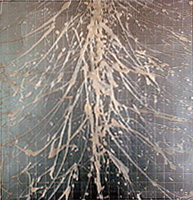home | metro santa cruz index | music & nightlife | mūz

The body transparent: Cheryl Calleri's 'Innervation' straddles the line between art and science at the Museum of Art and History.
Mūz
A Future in Acrylics
By Bill Forman
In addition to Simon & Garfunkel's "Mrs. Robinson," Mike Nichols' film The Graduate gave us the classic poolside scene where a family friend played by Walter Brooke offers young Dustin Hoffman's character a bit of timeless advice:
Brooke: I just want to say one word to you--just one word.
Hoffman: Yes, sir.
Brooke: Are you listening?
Hoffman: Yes, I am.
Brooke: "Plastics."
Hoffman: Exactly how do you mean?
Brooke: There's a great future in plastics. Think about it. Will you think about it?
Hoffman: Yes. I will.
Brooke: Shh! Enough said. That's a deal.
Forty years later, Thekla Hammond, Cheryl Calleri and Tobin Keller are living that future with a group exhibit based on the idea of exploring the human body and consciousness through the medium of transparent and reflective acrylic materials.
Titled Corpus Perspicuus: The Body Transparent, the installation runs through April 1 at Santa Cruz's Museum of Art and History. Last Thursday, the three artists held an evening panel discussion where they talked about their artwork as well as a range of no less interesting subjects ranging from the music of Samuel Barber to the joy of breeding fruit flies.
Hammond says the group exhibit grew out of her first meeting with Keller at a Cabrillo art exhibition and a subsequent dinner with Calleri and her husband that made it clear the three artists were kindred spirits. "I just fell in love with them," Hammond recalled, "and we were all working on the idea of layering, reflective surfaces, transparent materials and the human figure."
But getting gallery directors to fall in love with--let alone understand--the project was a more daunting task, according to Keller, an art instructor at Cabrillo College. Keller says the group approached "more than a dozen institutions" before finding its current home in Santa Cruz. The show will later resurface at the Hoffman Gallery in Portland's Lewis & Clark College, where an accompanying book will be published.
While the three artists are working with similar concepts, their styles are diverse. Visitors can walk though Hammond's installation of suspended translucent panels, each bearing the painted image of a faceless human figure, and encounter their own images in occasional mirrors along the way.
Keller's contributions are more personal, incorporating images of himself and friends into densely textured works, while Calleri evokes the human nervous system with her beautiful and intricately layered opalescent images on laminated acrylic sheets.
Calleri's dry humor and scientific fixations also drew the evening's biggest laughs, as she told how her next project will be a film homage to the drosophila, otherwise known as the fruit fly, "the backbone of DNA research for more than 100 years." To that end, she's created numerous images of fly brains, researched specs for an insect sound studio and hooked up with a composer who plans to employ frequencies favored by fruit flies. Along the way, she bought her own fruit flies for breeding purposes. "I've gone through many generations since," said Calleri. "Their life span is only a couple weeks."
Send a letter to the editor about this story.
|
|
|
|
|
|